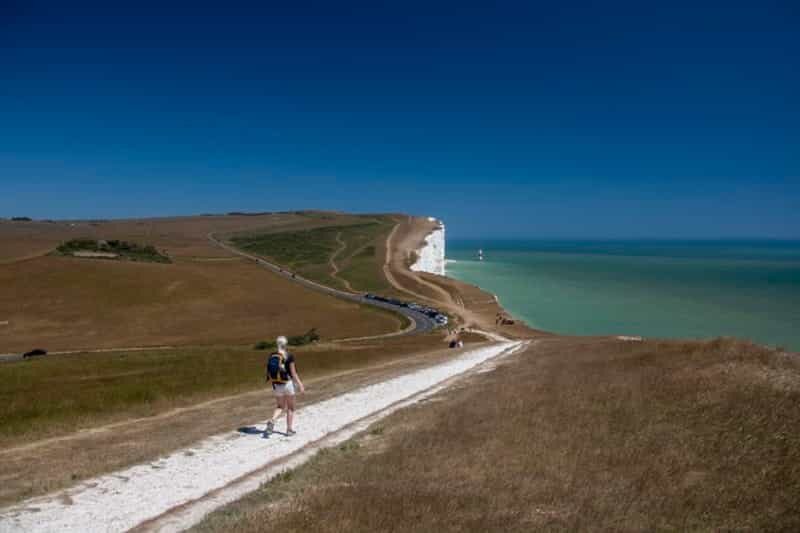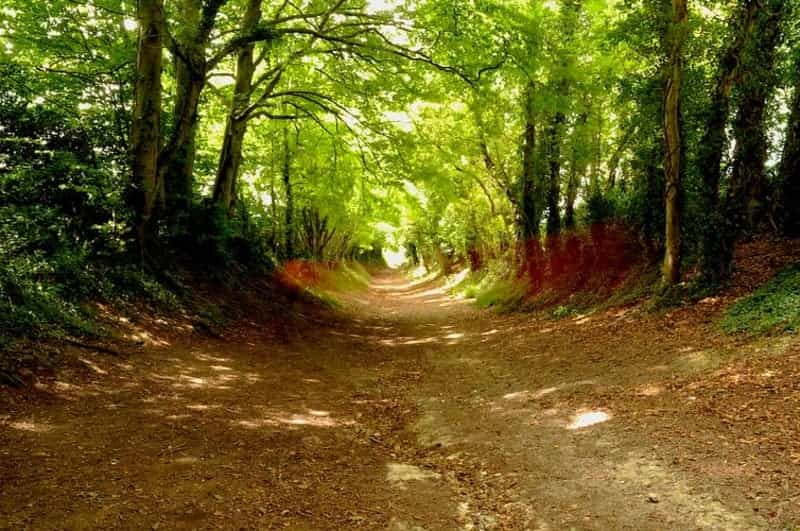12 Of The Best Walks & Trails In West Sussex
With numerous Areas of Outstanding Natural Beauty, National Trust estates and huge expanses of golden sand to choose from, there’s no shortage of options when it comes to the best walks and trails in West Sussex.
On the coast, you can follow the clifftop from Birling Gap to Beachy Head, or roam the immense sandy expanse of West Wittering Beach, near Chichester Harbour.
Inland, the scenic valley at Devil’s Dyke and an iron-age fort at Cissbury Ring are just two of the highlights in the South Downs National Park. And if you’re looking for a woodland walk with a bit of literary history thrown in, try Ashdown Forest, made internationally famous by A. A. Milne as the Hundred Acre Wood, home of Winnie the Pooh.
So whether you’re looking for gentle circular walks, a clifftop ramble with stunning views or just those little extras like tea rooms and car parks that help to make life easier, look no further.
Taking in lighthouses, windmills, reservoirs and Saxon churches, here are 12 of the best walks and trails in West Sussex for you to explore.

Devil’s Dyke
Said to have been dug by the Devil in an attempt to drown the local Christian populace with water from the sea, this deep, V-shaped valley is nearly a mile long. It sits below Iron Age fortifications with sweeping views of the South Downs, The Weald and, on a good day, the Isle of Wight. At the bottom of the valley, two prominent humps are said to be the graves of the Devil and his wife, so if you’re superstitious, you might like to avoid that bit…
Several dog-friendly National Trust trails cover the whole area. It’s a popular spot for paragliders too, and in spring the valley’s carpet of wildflowers attracts hundreds of butterflies.
Birling Gap to Beachy Head

It’s hard to get lost on this spectacular walk along the Seven Sisters cliffs. Start at the public car park and head off on the signposted trail by a row of coastguard cottages. On the way you’ll pass two lighthouses, and have unforgettable views out over the English Channel. It’s also possible to cover the whole stretch on the shingle beach below the cliffs, but only at low tide, so check the times carefully before you take it on.
In total, the two-mile walk takes around an hour, but of course that doesn’t account for picnics or several stops to admire the views. At the end, the Beachy Head Inn serves food, welcomes dogs, and has a pretty garden where you can reward yourself with a pint.
If you’d like to discover more of the best coastal walks in West Sussex, here’s a useful list.
Sheffield Park and Garden
This glorious landscaped garden and arboretum, laid out in the 18th century by Capability Brown, is home to four lakes surrounded by bridges and woodland trails. In summer, the lakes are covered in water lilies, attracting kingfishers and dragonflies, while from mid-September onwards the leaves begin to change colour in a kaleidoscopic display of gold, scarlet and yellow, all reflected in the water.
Dog owners will be delighted to hear that dogs on leads are welcome at all times.
Ashdown Forest
Author A. A. Milne was inspired by this ancient woodland to write his Winnie The Pooh books, which have delighted generations of adults and children. If you grew up on these whimsical tales, then don’t miss the chance to visit some of the sites where the action takes place. First on the list has to be Pooh Sticks Bridge, where the simple game was invented (and can still be played, of course). After that, there are two dedicated walks passing sites like Roo’s Sandy Pit and the Enchanted Place, as well as a memorial to the author.
Handy leaflets available from the Ashdown Forest Centre (or online) also detail 13 other walks among the trees that take in windmills, a World War II airstrip and views of the North and South Downs.
Halnaker Windmill Trail

Part of the Great Sussex Way, this gentle, well-signposted trail runs from the car park at Boxgrove Village Hall to the restored Halnaker Windmill. On the way, it passes through Mill Lane, where footsteps have worn away the path since Roman times, resulting in a photogenic ‘tunnel of trees’. There are great views over the countryside from the top of the hill, a Neolithic earthwork in a prime position that also made it an important observation point during World War II.
Cissbury Ring
Set on a chalk hilltop with commanding views over Worthing to the English Channel, this huge Iron Age hill fort is one of the highlights of the South Downs National Park. Kids and dogs love clambering around its grassy ramparts and ditches, which date back over 5,000 years.
The whole area is criss-crossed with paths, including a dog-friendly three-mile circular trail that begins at Storrington Rise car park and is designed to highlight local butterflies and colourful wildflowers. There are options to go further too, by linking up with the South Downs Way.
Nymans
Nymans is a pretty National Trust garden, set around the considerable remains of an elegant country house. You can meander along tree-lined avenues to take in its exotic plant collection, passing through stone arches, topiary hedges and vine-covered trellises. Visit in spring for daffodils and flowering magnolia trees, in summer for the rose gardens, and in autumn for spectacular displays of golden leaves.
Although the garden is off-limits for dogs, a dog-friendly trail from the car park heads off through the neighbouring woodland, home to foxes, badgers, owls and stoats.
River Rother Walk at Midhurst
This easy, three-mile circular walk passes through riverside woodland, grassy pastures and rolling parkland around the Woolbeding Estate, passing a woodland folly and a weir. It’s well worth a quick detour to visit the Saxon church at Woolbeding, renowned for its 16th-century stained glass windows, reinstated after the English Civil War.
The well-signposted trail (marked ‘Rother Walk’) begins in Midhurst. You can take a dog with you, but please keep them on a lead.
Ardingly Reservoir Walking Trail
Starting at a car park by the southern end of this huge lake, this quiet waterside path passes through a nature reserve that’s home to grebes and kingfishers. You might like to stop off at the tea room in Balcombe for a slice of cake before you return via the same route.
You get two for the price of one here – another short trail from the car park heads off along the river to the spectacular 19th-century Ouse Valley Viaduct, an immense structure built with millions of bricks, supported on 37 elegant arches. Built to last, it still carries trains on the London to Brighton line.
Jack and Jill Windmills to the Ditchling Beacon
This two-mile walk along the South Downs Way, straddling the border between East and West Sussex, starts beside a pair of elegant 19th-century windmills. The taller one, Jack, is a private home, but on summer Sundays you can visit the Jill Mill – which was (incredibly) dragged here by oxen in the 1850s.
The path heads off along a high chalk ridge (with views of the Weald, the Downs and the sea) to the Iron Age hill fort and nature reserve at Ditchling Beacon. Watch out for the Keymer Post, which marks the point where East Sussex begins.
West Wittering Beach
Backed by dunes and multicoloured beach huts, West Wittering sits right at the entrance to Chichester Harbour. The retreating tide reveals a massive expanse of sand with views across the Solent to the Isle of Wight, where you can roam for miles, play beach cricket or fly a kite. Amble along to the nature reserve at East Head for harbour views.
If you’re planning on bringing your dog, there are some minor restrictions between May and September, but there’s so much space that it really doesn’t matter. Outside of this busy time, dogs are allowed everywhere.
Has this beach captured your imagination? Then take a look at our list of the best sandy beaches in West Sussex.
If it wouldn’t be a walk without your canine companion, choose from our list of dog-friendly beaches in West Sussex.
Knepp Castle Estate
Only a single crumbling stone tower remains as a reminder of the original 12th-century stronghold on this country estate in the heart of the Sussex Weald. The 19th-century mansion that later replaced it was built by famed Georgian architect John Nash, who also designed Brighton’s Royal Pavilion. In recent times, the whole area has been subject to a rewilding project, so it’s now a wildlife haven that’s home to roaming wild ponies.
There are 16 miles of public footpaths for you to explore here, and if you want to find out more about the project, the estate also runs guided walking tours to view the results. Watch out for the five tree-viewing platforms along the way for a bird’s-eye view.
Need somewhere to stay? Check out our South East England camping guide.